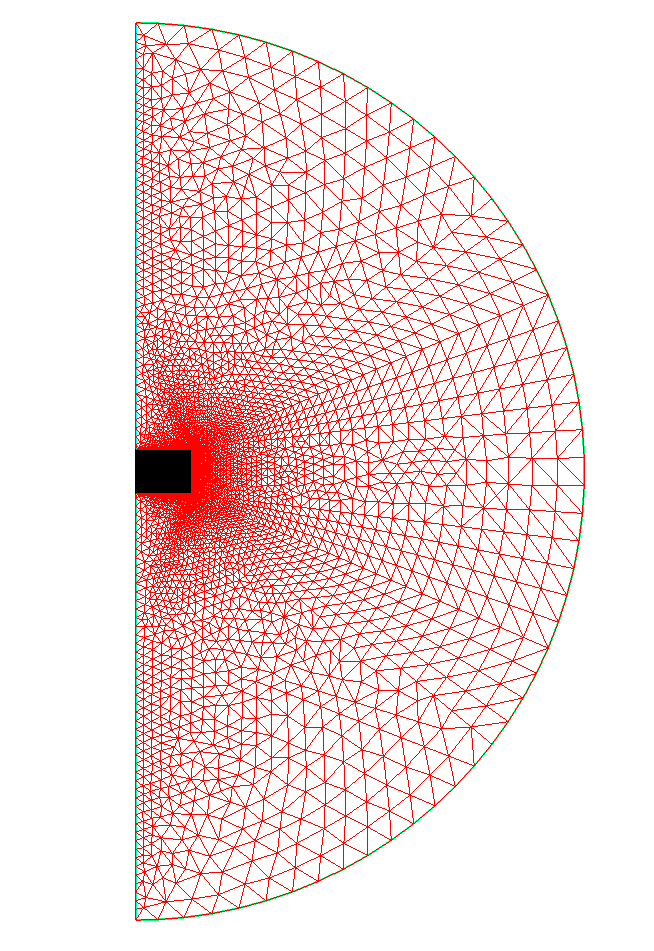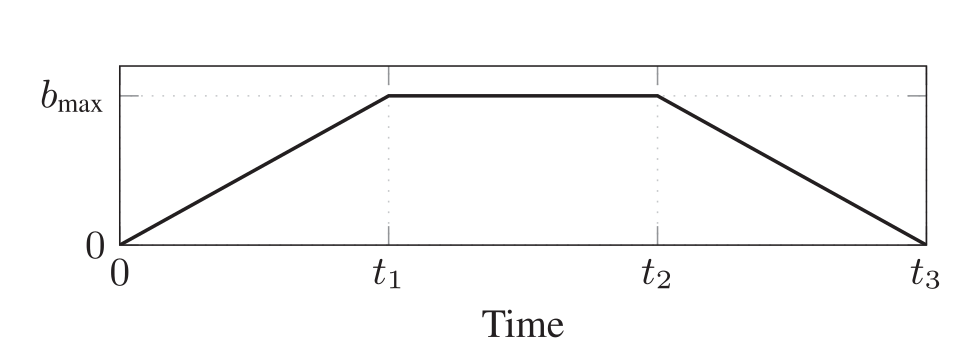Test Case : FreeFEM - Bulk Cylinder in Axisymmetric coordinates
1. Introduction
This is the test case of High-Temperature Superconductors with the A-V Formulation and Gauge Condition on a cylinder geometry surrounded by air in axisymmetric coordinates. The formulation used here is the Formulation in axisymmetric coordinates.
3. Data Files
The case data files are available in Github here :
-
EDP file - Edit the file
4. Equation
With :
-
\(A_{\theta}\) : \(\theta\) component of potential magnetic field
-
\(\sigma\) : electric conductivity \(S/m\) described by the e-j power law : \(\sigma=\frac{J_c}{E_c}\left(\frac{\mid\mid e\mid\mid}{E_c}\right)^{(1-n)/n} = \frac{J_c}{E_c}\left(\frac{\mid\mid -\partial_t A_\theta\mid\mid}{E_c}\right)^{(1-n)/n}\)
-
\(\mu\) : electric permeability \(kg/A^2/S^2\)
5. Geometry
The geometry is a rectangle in axisymmetric coordinates \((r,z)\) representing a bulk cylinder, surrounded by air.

Geometry in Axisymmetrical cut
|
The geometrical domains are :
-
Cylinder: the cylinder, composed by a conductor -
Air&Spherical Shell: the air surroundingConductor-
Symmetry Line:Air's bound, correspond to \(Oz\) axis (\(\{(z,r), \, z=0 \}\)) -
Exterior Boundary: the rest of theAir's bound
-
Symbol |
Description |
value |
unit |
\(R\) |
radius of cylinder |
\(0.00125\) |
m |
\(H_{cylinder}\) |
height of cylinder |
\(0.001\) |
m |
\(R_{inf}\) |
radius of infty border |
\(0.1\) |
m |
real BoxRadius = 0.1; //"Infinite" boundary
real SupraRadius = 0.0125;
real SupraHeight = 0.01;
int BoxWall = 10;
int Axis1 = 11;
int Axis2 = 12;
int Axis3 = 13;
border b1(t=-pi/2, pi/2){x=BoxRadius*cos(t); y=BoxRadius*sin(t); label=BoxWall;};
int nnA = max(2., BoxRadius*nn/2.);
border axis1(t=0., 1.){x=0; y=-BoxRadius+(BoxRadius-SupraHeight/2.)*t; label=Axis1;};
border axis2(t=0., 1.){x=0; y=BoxRadius-(BoxRadius-SupraHeight/2.)*t; label=Axis2;};
border s1(t=0., 1.){x=(SupraRadius)*t; y=-SupraHeight/2.;};
border s2(t=0., 1.){x=SupraRadius; y=-SupraHeight/2.+SupraHeight*t;};
border s3(t=0., 1.){x=SupraRadius-(SupraRadius)*t; y=SupraHeight/2.;};
border s4(t=0., 1.){x=0; y=SupraHeight/2.-SupraHeight*t; label=Axis3;};
The mesh is also generated in FreeFEM :

Mesh of Geometry
|
6. Parameters
The parameters of the problem are :
-
On
Cylinder:
Symbol |
Description |
Value |
Unit |
\(\mu=\mu_0\) |
magnetic permeability of vacuum |
\(4\pi.10^{-7}\) |
\(kg \, m / A^2 / S^2\) |
\(t_f\) |
final time |
\(15\) |
\(s\) |
\(b_{max}\) |
maximum applied field |
\(1\) |
\(T\) |
\(rate\) |
rate of the applied field raise |
\(\frac{3}{tf}b_{max}\) |
\(T/s\) |
\(hsVal\) |
time ramp for the applied field |
\(\begin{cases}rate*t &\quad\text{if }t<\frac{t_f}{3}\\b_{max} &\quad\text{if }t<\frac{2t_f}{3}\\b_{max} - (t-\frac{2t_f}{3})*rate &\quad\text{if }t>\frac{2t_f}{3}\end{cases}\) |
\(T\) |
\(J_c\) |
critical current density |
\(3.10^8\) |
\(A/m^2\) |
\(E_c\) |
threshold electric field |
\(10^{-4}\) |
\(V/m\) |
\(n\) |
material dependent exponent |
\(20\) |
|
\(\sigma\) |
electrical conductivity (described by the \(e-j\) power law) |
\(\frac{J_c}{E_c}\left(\frac{\mid\mid e\mid\mid}{E_c}\right)^{(1-n)/n}\) |
\(S/m\) |
-
On
Air:
Symbol |
Description |
Value |
Unit |
\(\mu=\mu_0\) |
magnetic permeability of vacuum |
\(4\pi.10^{-7}\) |
\(kg \, m / A^2 / S^2\) |
On the EDP file, the parameters are written :
real Mu0 = 4.*pi*1.e-7; func Nu = 1./Mu0; real T = 15; real dt = .05; real t = 0; real bmax = 1; real rate = 3.0/T*bmax; real jc = 3.e+8; real ec = 1.e-4; real epsSigma = 1.e-8; int n = 20; macro sigma(u) x*jc/ec*1.0/(epsSigma + ( abs(-(u-uold)/dt/ec )^((n-1.0)/n) ))
7. Weak Formulation
8. Implementation of Weak Formulation
On FreeFEM, we need to implement the weak the Weak Formulation :
On the EDP file, the weak formulation is written :
problem mqs(u, v, solver=sparsesolver, eps=1.e-10)
= int2d(Th)(sigma(uu)*(region==Supra) * u'*v/dt)
- int2d(Th)(sigma(uu)*(region==Supra) * uold*v/dt)
+ int2d(Th)(Nu * Grad(u)' * Grad(v) * x)
+ int2d(Th)(Nu * u' * v / x)
+ on(BoxWall, u=uinit * x/2)
+ on(Axis1, u=uinit * x/2)
+ on(Axis2, u=uinit * x/2)
+ on(Axis3, u=uinit * x/2)
;
9. Boundary Conditions
For the Dirichlet boundary conditions, we want to impose the applied magnetic field :
So we have \(B=hsVal\), therefore \(\nabla\times A = hsVal\) and so \(\frac{1}{r}\partial_r (rA_\theta)=hsVal\).
Finally we have :
-
On
Symmetry Line&Exterior Boundary: \(A_{\theta} = \frac{r}{2}hsVal\)
In the previous section, the boundary condition were written as : .Boundary conditions in the weak formulation on EDP file
+ on(BoxWall, u=uinit * x/2)
+ on(Axis1, u=uinit * x/2)
+ on(Axis2, u=uinit * x/2)
+ on(Axis3, u=uinit * x/2)
\(\texttt{uinit}=hsVal\) here, and it will be updated for each timestep in the solver part of the EDP file, the boundary conditions are written :
for(real t = 0; t <= T; t += dt){
uinit = bmax - (t-2.0*T/3.0)*rate + (t<2.0*T/3.0)*(t-2.0*T/3.0)*rate + (t<T/3.0)*(t*rate - bmax);
[...]
10. Numeric parameters & Solver
-
Time
-
Initial Time : \(0s\)
-
Final Time : \(15s\)
-
Time Step : \(1s\)
-
-
Non-linear Solver : Picard
for(real t = 0; t <= T; t += dt){
string cmt = "t=" + t +" s";
uinit = bmax - (t-2.0*T/3.0)*rate + (t<2.0*T/3.0)*(t-2.0*T/3.0)*rate + (t<T/3.0)*(t*rate - bmax);
cout << "t=" << t << " s," << "a=" << uinit <<endl;
uold = u; //equivalent to u^{n-1} = u^n
err = 1.;
int i = 1;
while (abs(err)>=toll) {
mqs;
uu=u;
err=(abs(u(0,0)-ue(0,0)))/(u(0,0));
cout<<"Convergence at (x,y)=(0,0), err:"<< err << " iter:" << i << endl;
ue=u;
i++;
}
ue = u;
}
11. Results
The results that we obtain with this formulation with Feelpp are compared to the results of the article Finite-Element Formulations for Systems With high-temperature Superconductors where the solver getDP is used.
The time evolution of the applied field is :

Time evolution of the external applied field
|
With \(t_1=5s\), \(t_2=10s\) and \(t_3=15s\)
11.1. Electric current density
The electric current density \(J_\theta\) is defined by :
With :
We compare the current density profiles with FreeFEM and getDP on the \(O_r\) axis, at the mid-height of the cylinder, at time \(t_3\) for a maximum applied field of 1 T and \(n=20\), for a mesh of 30199 nodes.
L2 Relative Error Norm : \(35.84 \%\) |
11.2. Magnetic flux density
The magnetic flux density \(B\) is defined by:
magnetic flux density magnitude \(B (T)\)
|
We compare the distribution of the z-component of the magnetic flux density 2mm above the cylinder at the instants \(t_1\), \(t_2\) and \(t_3\) with Feelpp and getDP.
t1 \(=5s\) |
L2 Relative Error Norm : \(2.5 \%\) |
t2 \(=10s\) |
L2 Relative Error Norm : \(2.36 \%\) |
t3 \(=15s\) |
L2 Relative Error Norm : \(7.44 \%\) |
12. References
-
Finite-Element Formulation for Systems with High-Temperature Superconductors, Julien Dular, Christophe Gauzaine, Benoît Vanderheyden, IEEE Transactions on Applied Superconductivity VOL. 30 NO. 3, April 2020, PDF